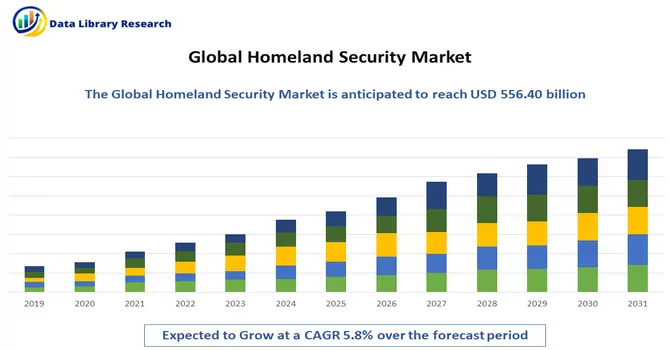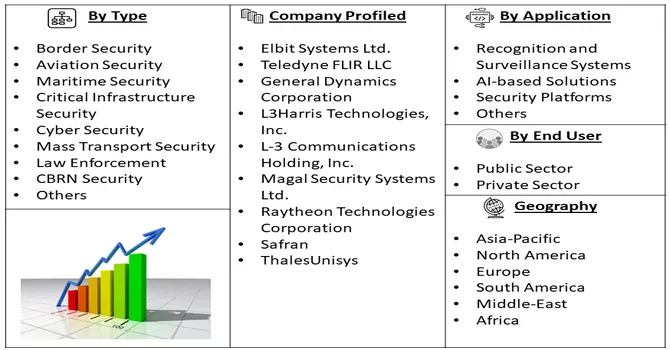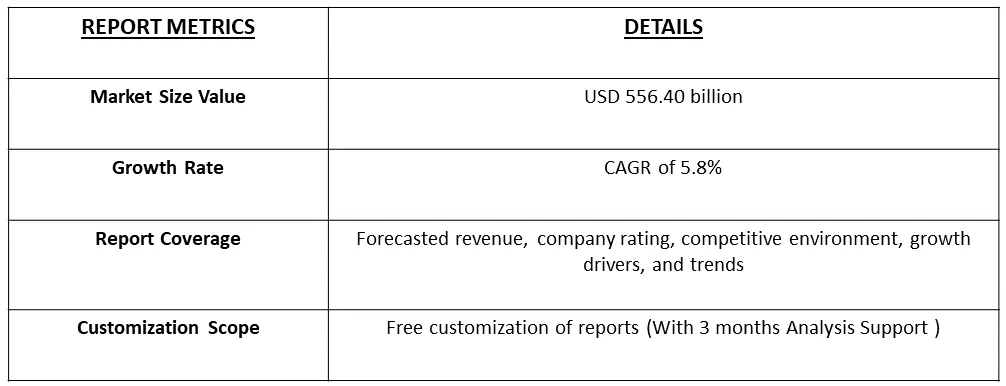In 2022, the global homeland security market reached a valuation of USD 556.40 billion, and it is projected to experience a compound annual growth rate (CAGR) of 5.8% from 2023 to 2030.

Get Complete Analysis Of The Report - Download Free Sample PDF
The escalating demand for safety equipment and solutions within diverse sectors, including aviation, maritime, cyber, and border security, is poised to be a primary driver of market expansion throughout the forecast period. This anticipated growth is fueled by an increasing need for robust security measures across various industries.
Homeland Security refers to a concerted and comprehensive effort by a government to protect its nation from various threats and hazards, both internal and external, with the primary goal of safeguarding the safety and well-being of its citizens, infrastructure, and institutions. It involves a wide range of activities, strategies, and measures aimed at preventing, responding to, and recovering from emergencies, disasters, and security challenges.
The global homeland security market is expected to witness substantial growth globally, propelled by a multitude of factors. These include a heightened occurrence of terrorist attacks, cross-border conflicts, illegal immigration, smuggling activities, human trafficking, and the frequent incidence of natural disasters. The rising complexity and diversity of security threats contribute to the accelerated pace of market development, as nations and industries seek advanced technologies and strategies to safeguard against evolving risks and challenges.
The Homeland Security market is witnessing a trend of rapid technological advancements, including the integration of artificial intelligence (AI), machine learning, and advanced analytics to enhance threat detection, response capabilities, and overall situational awareness. With the increasing frequency and sophistication of cyber threats, there is a growing emphasis on enhancing cybersecurity measures within the Homeland Security market. This includes the development of robust defenses against cyberattacks targeting critical infrastructure and sensitive information. Moreover, Governments worldwide are investing in advanced border security technologies to address challenges related to illegal immigration, human trafficking, and the smuggling of contraband. This involves the deployment of surveillance systems, biometric identification, and other cutting-edge solutions.
Market Segmentation: The Homeland Security Market Size, Share & Trends Analysis Report By Types (Aviation, Maritime, Border, Critical Infrastructure Security, Cybersecurity, CBRN Security & Mass Transit Security), and By Region North America, Europe, Asia Pacific, Middle East and Africa, and South America). The report offers the value (in USD million) for the above segment.

For Detailed Market Segmentation - Download Free Sample PDF
Market Drivers:
The Increase In Demand For Safety Equipment And Solutions Across Several Industries Such As Aviation, Maritime, Cyber, And Border Security.
The surge in demand for safety equipment and solutions across various industries, including aviation, maritime, cyber, and border security, reflects a heightened awareness of the evolving threats and challenges that nations and organizations face.According to the Congressional Research Service Report of July 2022, More than 95 countries reportedly operated some unmanned military aircraft in 2021. The most advanced UAS are built in the United States. Iran, Israel, China, and Turkey, however, have shown rising degrees of competence in their approaches to unmanned technologies in recent years, with Iranian, Chinese, and Turkish UAS playing a notable role in recent military actions. Moreover, in the aviation sector, the demand for safety equipment is propelled by the continuous need to enhance passenger safety and protect aircraft from potential threats, including terrorism and hijacking. Advanced screening technologies, biometric identification systems, and cybersecurity measures are integral components of aviation security to ensure the integrity of air travel. Furthermore, the rise in global security concerns, including cross-border disputes, illegal immigration, and smuggling activities, has led to an increased demand for safety equipment along national borders. Advanced surveillance technologies, biometric identification, and physical barriers contribute to securing borders and preventing unauthorized entry.
The Rising Cases Of Terrorist Attacks, Cross-Border Disputes, Illegal Immigration, Smuggling, Human Trafficking, And The Occurrence Of Numerous Natural Disasters
The escalating incidences of various security challenges pose a growing concern for Homeland Security agencies worldwide. Several factors contribute to this complex and dynamic security landscape, necessitating robust measures to safeguard nations and their citizens. The persistent threat of terrorist attacks remains a critical concern for Homeland Security. Global terrorist networks and lone-wolf actors pose a diverse range of threats, requiring advanced intelligence, surveillance, and counterterrorism strategies to prevent and respond effectively. Homeland Security agencies play a pivotal role in addressing these multifaceted challenges through comprehensive strategies that encompass intelligence gathering, risk assessment, technology integration, and international collaboration. The development and deployment of advanced technologies, such as satellite imagery, biometrics, and data analytics, contribute to enhancing situational awareness and response capabilities. Moreover, the evolving nature of security threats requires a proactive approach to research and development, continuous training of personnel, and the adoption of cutting-edge technologies to stay ahead of emerging risks. By understanding and adapting to the dynamic security landscape, Homeland Security agencies aim to create resilient and secure environments for nations, fostering global stability and safeguarding the well-being of citizens.
Market Restraints :
Regulatory Challenges
Market restraints refer to factors or conditions that hinder the growth, development, or performance of a particular market. These limitations can impede the ability of businesses or industries to achieve their full potential and may include various challenges and barriers. Stringent or complex regulations imposed by government authorities can act as a restraint on market growth. Compliance with these regulations may require significant resources and can limit the flexibility of businesses.
The COVID-19 pandemic has had a significant impact on the Homeland Security market, introducing both challenges and opportunities as the world grapples with the consequences of the global health crisis. Many countries implemented stringent border controls and travel restrictions to curb the spread of the virus. This led to a heightened focus on border security and the need for advanced technologies to monitor and manage border crossings. The pandemic emphasized the importance of protecting critical infrastructure, including healthcare facilities, energy resources, and communication networks. Homeland Security efforts were directed towards enhancing the resilience of critical infrastructure to ensure the continuity of essential services. The pandemic highlighted the importance of international collaboration in addressing global threats. Homeland Security agencies engaged in information sharing, joint exercises, and collaborative efforts to enhance preparedness and response capabilities on a global scale.
Segmental Analysis :
Aviation Segment is Expected to Witness Significant Growth Over the Forecast Period
The intersection of aviation and homeland security represents a critical nexus where measures are implemented to ensure the safety and security of air travel, protect critical infrastructure, and mitigate potential threats. The Aviation and Homeland Security market encompasses a range of technologies, strategies, and solutions designed to address evolving challenges. Ensuring the security of airports is a fundamental component of aviation and homeland security. Advanced screening technologies, access control systems, and surveillance measures are implemented to detect and prevent potential threats to passengers, aircraft, and airport facilities. Thus, the segment is expected to witness significant growth over the forecast period.
North America Region is Expected to Witness Significant Growth Over the Forecast Period
North America plays a crucial role in the global Homeland Security market, given its economic significance, technological advancements, and the diverse range of security challenges faced by the region. The Homeland Security market in North America encompasses various sectors and activities aimed at ensuring the safety and security of its citizens, critical infrastructure, and borders. Given its extensive land borders, North America places a strong emphasis on border security. The U.S. and Canada collaborate on initiatives and technologies to monitor and control border crossings, detect illegal activities, and prevent unauthorized entry.
The North American aviation sector places a strong emphasis on security, with measures ranging from advanced passenger screening technologies at airports to cybersecurity measures for air traffic control systems. Collaboration between the U.S. and Canada further enhances aviation security in the region. Moreover, in March 2022, Teledyne FLIR Defense, a subsidiary of Teledyne Technologies Incorporated announced the launch of a Lightweight Vehicle Surveillance System (LVSS) with innovative air domain awareness (ADA) and expanded counter-unmanned aerial system (C-UAS) features. LVSS ADA C-UAS is a better version of Teledyne FLIR's field-proven LVSS structure, including dependable, easy deployment, and cutting-edge technology to detect and defeat the growing threat of micro drones. Thus, such factors are expected to contribute to the growth of the market in the region.

Get Complete Analysis Of The Report - Download Free Sample PDF
The strategy of mergers and acquisitions (M&A) is a common approach adopted by key players in various markets, including Homeland Security, to achieve business growth, expand product and service portfolios, and enhance overall market competitiveness. M&A allows companies to diversify their product and service portfolios by integrating complementary offerings. For example, a company specializing in cybersecurity solutions might acquire a firm with expertise in physical security systems, creating a more comprehensive suite of Homeland Security solutions. Some of the key market players working in this segment are:
Recent Developments
1) In April 2023, L3Harris Technologies, Inc., a prominent U.S.-based technology firm, declared the successful conclusion of testing for their groundbreaking Positioning, Navigation, and Timing (PNT) technology in collaboration with the U.S. Air Force Research Lab (AFRL). The objective of this initiative is to assess the potential of U.S. space-based military PNT, showcasing vital technologies designed to address threats to national security.
2) Simultaneously, in April 2023, the Biennial National Strategy for Transportation Security (NSTS) from the United States Department of Homeland Security (DHS) was unveiled. This strategic document outlines new initiatives in transportation security, featuring an open architecture approach to Transportation Security Equipment (TSE) systems architecture and the implementation of One-Stop Security to streamline international travel. The overarching policy aims to fortify the security of the nation's transportation systems, protecting them from potential assaults or damage orchestrated by terrorists or other violent entities, covering the period from 2023 through 2027. •
Q1. What was the Homeland Security Market size in 2022?
As per Data Library Research the global homeland security market reached a valuation of USD 556.40 billion in 2022.
Q2. What is the Growth Rate of the Homeland Security Market?
Homeland Security Market is projected to experience a compound annual growth rate (CAGR) of 5.8% over the forecast period.
Q3. Who are the key players in Homeland Security Market?
Some key players operating in the market include
Q4. Which Region is expected to hold the highest Market share?
North American region is expected to hold the highest Market share.
Data Library Research are conducted by industry experts who offer insight on industry structure, market segmentations technology assessment and competitive landscape (CL), and penetration, as well as on emerging trends. Their analysis is based on primary interviews (~ 80%) and secondary research (~ 20%) as well as years of professional expertise in their respective industries. Adding to this, by analysing historical trends and current market positions, our analysts predict where the market will be headed for the next five years. Furthermore, the varying trends of segment & categories geographically presented are also studied and the estimated based on the primary & secondary research.
In this particular report from the supply side Data Library Research has conducted primary surveys (interviews) with the key level executives (VP, CEO’s, Marketing Director, Business Development Manager and SOFT) of the companies that active & prominent as well as the midsized organization
FIGURE 1: DLR RESEARH PROCESS

Extensive primary research was conducted to gain a deeper insight of the market and industry performance. The analysis is based on both primary and secondary research as well as years of professional expertise in the respective industries.
In addition to analysing current and historical trends, our analysts predict where the market is headed over the next five years.
It varies by segment for these categories geographically presented in the list of market tables. Speaking about this particular report we have conducted primary surveys (interviews) with the key level executives (VP, CEO’s, Marketing Director, Business Development Manager and many more) of the major players active in the market.
Secondary ResearchSecondary research was mainly used to collect and identify information useful for the extensive, technical, market-oriented, and Friend’s study of the Global Extra Neutral Alcohol. It was also used to obtain key information about major players, market classification and segmentation according to the industry trends, geographical markets, and developments related to the market and technology perspectives. For this study, analysts have gathered information from various credible sources, such as annual reports, sec filings, journals, white papers, SOFT presentations, and company web sites.
Market Size EstimationBoth, top-down and bottom-up approaches were used to estimate and validate the size of the Global market and to estimate the size of various other dependent submarkets in the overall Extra Neutral Alcohol. The key players in the market were identified through secondary research and their market contributions in the respective geographies were determined through primary and secondary research.
Forecast Model
